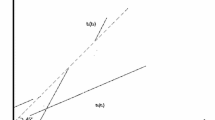Conclusion
This study derives long-run income distributional impacts of immigration and capital flows in a general equilibrium model of Canada. While each factor is its own enemy, results indicate that capital and skilled professional labor are enemies as well. Both of these productive inputs are friends of other labor groups, which are common enemies. Factor friendship patterns are useful in evaluating income distributional impacts of a variety of policies designed to influence the international flow of productive labor and capital.
Similar content being viewed by others
References
W. W. Chang, “Some Theorems of Trade and General Equilibrium with Many Goods and Factors,”Econometrica, 47, 1979, pp. 709–26.
D. DeVoretz and D. Maki, “The Size and Distribution of Human Capital Transfers from LDCs to Canada: 1966–1973,”Economic Development and Cultural Change, 28, 1980, pp. 779–800.
__, “The Immigration of Third World Professionals to Canada: 1968–1973,”World Development, 11, 1983, pp. 55–64.
M. J. Greenwood, “Leading Issues of Fact and Theory,”American Economic Review, 73, 1983, pp. 173–77.
F. Hawkins,Canada and Immigration: Public Policy and Public Concern, Montreal: McGill-Queen's University Press, 1972.
__, “Canadian Immigration Policy and Management,”International Migration Review, 8, 1974, pp. 141–53.
International Labor Organization,Yearbook of Labor Statistics: 1980, New York: International Labor Organization, 1982.
R. W. Jones, “The Structure of Simple General Equilibrium Models,”The Journal of Political Economy, 73, 1965, pp. 557–72.
L. Parai, “Canada's Immigration Policy, 1962–74,”International Migration Review, 9, 1975, pp. 449–77.
H. Posner,Factor Content of Canadian International Trade: An Input-Output Analysis, Ottawa: Economic Council of Canada, 1975.
R. J. Ruffin, “Trade and Factor Movements with Three Factors and Two Goods,”Economics Letters, 7, 1981, pp. 177–82.
J. B. Shoven and J. Whalley, “Applied General Equilibrium Models of Taxation and International Trade: An Introduction and Survey,”The Journal of Economic Literature, 22, 1984, pp. 1007–51.
Statistics Canada,Census of Canada, 1971: Public Use Samples, magnetic tape, 1975.
__,Canada Yearbook 1980–81, Ottawa: Minister of Supply and Services, 1981.
A. Takayama, “On Theorems of General Competitive Equilibrium of Production and Trade — A Survey of Some Recent Developments in the Theory of International Trade,”Keio Economic Studies, 19, 1982, pp. 1–37.
H. Thompson, “Factor Migration and Income Redistribution in International Trade,”Keio Economic Studies, 20, 1984, pp. 65–70.
__, “Factor Movements with Three Factors and Two Goods in the U.S. Economy,”Economics Letters, 12, 1983, pp. 53–60.
United Nations,Yearbook of National Account Statistics: 1980, New York: United Nations, 1982.
Author information
Authors and Affiliations
Rights and permissions
About this article
Cite this article
Clark, D.P., Thompson, H. Immigration, international capital flows, and long run income distribution in Canada. Atlantic Economic Journal 14, 24–29 (1986). https://doi.org/10.1007/BF02303211
Issue Date:
DOI: https://doi.org/10.1007/BF02303211




